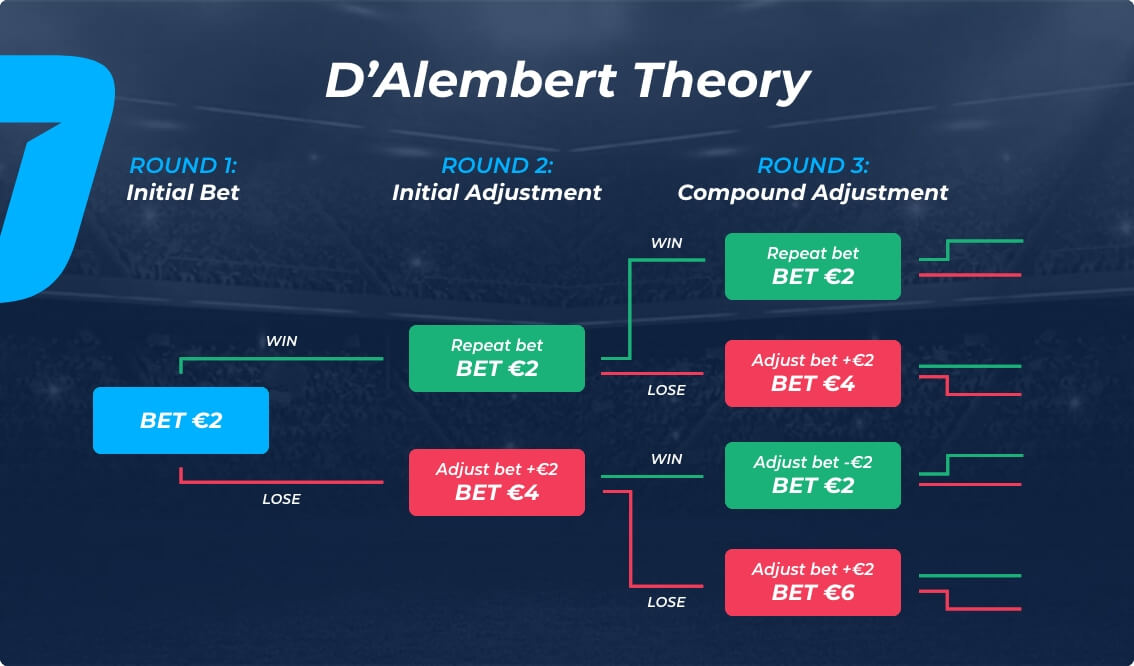
D’Alembert Betting System Explained: D’Alembert System Betting Guide and Tips
What is the D'Alembert Betting System?
When looking at simple systems for betting, the name D'Alembert will always pop up in your research. The main reason is that D'Alembert is one of the most straightforward betting systems in the industry. It is at the top of the chain, probably coming in second after another famous system called the Martingale system. The system is directly involved in the increase of stakes, which is a form of negative progression. This comes after losing a bet and ensuring they are decreased right after winning a bet.
Essentially, after losing, the D'Alembert betting system requires bettors to increase their next bet by one unit.
In the D'Alembert betting system, the bet increase is done slowly compared to other systems. The slow increase process makes the likelihood of the stakes getting high less likely. This makes the system very advantageous to some level, but the recovery of the stakes will be much slower. The slow recovery is a negative aspect since the losses can be pretty high even if the size of each loss is less dangerous.
History of the D'Alembert Method
The D'Alembert formula is a method that dates back to the late 18th century when gambling was becoming more prevalent. The name comes from the inventor, who was a French mathematician at that time. The method was mainly used for gambling. It included an increase of wagers by players after losing and spearheaded to get the money in the future. The loss was more of a sign that the future bets would be profitable as they would win more.
The method has become widely used even in the 21st century's betting markets. It is now used in many more games and is still popular with many players who prefer simple betting strategies.
How the D'Alembert Method Works
It is essential to understand how the D'Alembert method works to make the most of it when starting. Like any other betting system, the D'Alembert method also allows you to make real money wins. The system also provides you opportunities to make profits even if you lose some bets along the way.
First, you might need to know how to get the recommended sequences of the process's results to ensure you are utilising the advantages. Through this technique, the system may seem flawed since it can get quite expensive because the possibilities of the sequences are endless. The lost bets may end up being in several sequences. The profitability is mainly short-term.
How to Use the D'Alembert Method
To use D'Alembert's method, you must use the rules and understand each. There are four rules to the D'Alembert method. These are:

RULE 1 – Decide Your Base Unit
The first rule is deciding your base unit. This is the choice for your base staking. It can be any percentage you want, but it is advisable to keep it either 5% or less of the total amount you have in your bankroll. Starting from 2% is an excellent option for you.
RULE 2 – Begin with One Unit
The second rule is where you decide to stake on one base unit. This staking unit will be on the first wager of the cycles in the D'Alembert system.
RULE 3 – Increase Stakes After a Loss
The third rule is applicable after making a loss on the stake you placed. Any wager lost will need to get an increase in the stake by one staking unit. Gradually increase the stake from the previous one placed.
RULE 4 – Decrease Stakes After a Win
In rule 4, you must decrease the wager by one base unit for every winning bet.
D'Alembert System Example when Applied to Sports, Betting
A clear example of how this works is a good guideline for utilising the D'Alembert system. The following is an excellent example of how the D'Alembert system can be applied to sports betting.
You need to understand that it is a unit-based system. Betting with $10 on your first bet gives you $10 as your primary base unit.
If you lose a wager, the system needs you to increase the stake on your next bet by a unit. You will add one more unit of $10, so the next bet will be $20. If the bet ends up being a loss, the third bet will increase by $10 and be $30. The stakes gradually increase depending on the outcome.
D'Alembert Betting System Football Example
Using the D'Alembert betting system in football is relatively straightforward.

Pick the match event you are planning to bet on. Look at the betting odds and choose the team you want to bet on. Make sure the odds are at least 2.00. You can start with £100 on your bet, with conditional bets 2. Place £100 and if it doesn't pass, put £200. If that doesn't pass, put £300 and then £400. If it passes, you will get £800 from doubling the £400. The process continues like that.
Other Uses of the D'Alembert System
The D'Alembert system has a variety of uses in sports betting, among other sectors. It can be used expansively in its own right. You can use it as an aggressive system play based on the sequences by changing the bet changes as you wish. The reverse D'Alembert system is another use you can apply to a couple of gameplays.
D'Alembert System for Roulette
Playing Roulette applies the D'Alembert system in almost all of its functionalities. Roulette games are very popular with the D' Alembert system. Its popularity is closely linked to the advantages it offers in Roulette games. Winning in Roulette through this game has never been easier. As long as you consider all the processes involved in using the D'Alembert system, you can always be sure to get the benefits you deserve through the outcomes.
D'Alembert System for Blackjack
The D'Alembert system is also applicable to blackjack. The system doesn't necessarily make the game different but enhances overall gameplay. When used in blackjack, the strategy has a bit of change. If you lose, you will gradually increase your bet amount, but you may win through the additional amount on the bets. The more sequences you add, the more your chances of winning get. So, you need to keep up with the process continuously.
Variants of the D'Alembert System
Variations are common in betting systems, and the D'Alembert System is not so different. The D'Alembert System is diverse and has its variants too. The primary variant is the reverse D'Alembert System, and the multi-variants are the two main variants of the D'Alembert System. They work with the basic structure of the D'Alembert System.
Multi D'Alembert Progression
Multi D'Alembert Progression is a system variable in a popular game like Roulette. The progressions can be either positive or negative, and both of these have different overall outcomes. Depending on the games and the bets, the multi-progressions can either be advantageous or disadvantageous.
The Reverse D’Alembert
Like other simple betting systems, the D'Alembert System has a reverse side. The reverse D'Alembert System is like another method within the same D'Alembert system since it uses the same principles and strategies but with slight differences. With this strategy, you are required to make all choices in reverse. Take the D'Alembert System and start from the other side, reversing the entire process.
 Bet $5, Get $150 in Bonus BetsNo code required Claim bonus
Bet $5, Get $150 in Bonus BetsNo code required Claim bonusNew customers only. 21+. Wager your first $5+ and if you win, you'll be awarded $150 in bonus bets. Gambling Problem? Call 1-800-GAMBLER. FanDuel Sportsbook available in AZ, CT, CO, IA, IL, IN, KS, KY, LA, MA, MD, MI, NJ, NY, NC, PA, OH, TN, VA, VT, WV, WY only. Full T&Cs apply.
 Up to a $500 Second-chance BetClaim bonus
Up to a $500 Second-chance BetClaim bonusPayout on Free Bet wagers includes profits only(stake not returned). Must be 21+ and physically present in U.S. T&Cs apply.
 Up to $1,500 back in Bonus BetsClaim bonus
Up to $1,500 back in Bonus BetsClaim bonusPlace your first wager and receive up to $1,500 back in Bonus Bets if the bet loses. If the bet does lose, your Bonus Bets will be available once your initial wager is settled. Must be 21+ and located in the U.S. T&Cs apply. Please Gamble Responsibly!
 Get $100 when you bet $20No code required Claim bonus
Get $100 when you bet $20No code required Claim bonusFree bets will be broken down into 10 x $10 bets. Must be 21+ and located in the US at time of wagering. T&Cs apply.
 Bet $5, Get $200 + No Sweat NBA SGP TokensNo code required Claim bonus
Bet $5, Get $200 + No Sweat NBA SGP TokensNo code required Claim bonusRegardless of the outcome of the wager the bonus will be awarded as six(8) $25 Bonus Bets. Must be 21+ years of age or older and physically located in the U.S(AZ, CO, CT, IA, IL, IN, KS, KY, LA (select parishes), MA, MD, ME, MI, NC, NJ, NY, OH, PA, TN, VA, VT, WY or WV). New customers only. T&Cs apply.
D'Alembert Betting System FAQ
❔ Who was D'Alembert?
🏆 Is the D'Alembert Strategy Illegal?
💶 Is the D'Alembert sYstem Allowed at Bookmakers?
💳 Is the D'Alembert Betting System a Safe Method?
🤔 Can I Bet on Football with The D'Alembert Method?
Advantages and Disadvantages of the D'Alembert System
- The variance on the D'Alembert System is much lower compared to the negative progressions of other simple betting systems. So, your losses will be less likely to pile up
- You can always control your bankroll effectively/pros-item]<br/> [pros-item]The freedom to control this makes it a viable option in games like Roulette
- The freedom to control this makes it a viable option in games like Roulette
- It is also safer than a lot of other systems
- D'Alembert System makes it hard to win back every bet that you lost as they pile up
- Staking up your winning can be a challenge
- Betway Challenge. (2021). Https://Blog.Betway.Com. https://blog.betway.com/casino/roulette-strategy-101-what-is-the-dalembert-betting-system/
- Wikipedia contributors. (2022, January 14). Roulette. Wikipedia. https://en.wikipedia.org/wiki/Roulette

